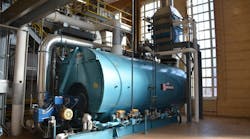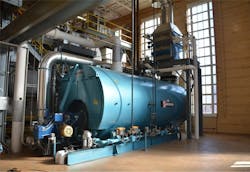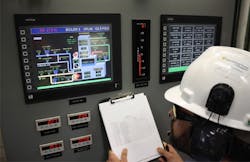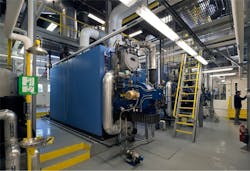What you don't know about energy efficiency could cost you
Everyone knows that energy efficiency is a critical component of a successful plant, but are you taking the right steps to achieve the greatest return? Download this free eBook for practical tips for improving energy efficiency at your plant.
The average large industrial boiler can operate normally for more than 20 years, but as a boiler ages, operating costs and reliability concerns can crop up. In light of new efficiency regulations, many more organizations are opting to replace traditional boilers, but this can be a costly and complicated process. Plant and building owners and operators are looking for increased efficiency, reliability, automation, value, and ease of maintenance when considering new boilers.
Watertube boilers
Industrial watertube boilers are used primarily in district energy applications and process industries, including chemical manufacturing, paper manufacturing, and refining. Watertube boilers are generally manufactured in D- and O-style configuration and are used when high steam pressures are required – generally 100 psig pressure and higher. The D and O configuration describes the relationship of the steam mud drums and interconnecting tubes. Thermal efficiencies for watertube boilers without economizers are typically between 75% and 80%. The efficiency gain from adding a conventional flue gas economizer can be 3% to 5% or more.
Watertube boilers have smaller reserves of water but large heating surface areas; this allows for faster initial steaming times and quick responses to changes in steam pressure. However, the smaller water reserve means a more-responsive water level control is required.
Small-diameter (2”-3”) steel tubes allow for significant operating pressures (600 psi+) before special alloys are required. When properly maintained, watertube boilers often have service lives of 30 years or more before rebuilding is necessary. Replacing tubes in these units can be labor-intensive and may require disassembly of the casing as well as a significant amount of workspace. Typically, many tubes have to be removed and reinstalled to make the repair on a particular tube. Packaged watertube boilers often have applications beginning at the 20,000 PPH (600 hp) size, and can be shipped as shop-assembled units or field-erected in place. Their high output vs. small footprint make them especially suitable for the large steam plants that must produce hundreds of thousands or millions of pounds of steam per hour.
The introduction of computational fluid dynamics, or CFD, modeling to the boiler industry is arguably the most significant technological advancement of the past 25 years in watertube boiler design. Once a tool reserved for aerospace engineers, CFD has allowed manufacturers to combine decades of field data with cutting-edge computer modeling to develop larger, more-efficient designs, often in the same footprint as older units. As a result, both watertube and firetube boilers have grown significantly in capacity over the years. Firetubes are now available in sizes nearing 2,500 hp.
In the past, 250,000 PPH of steam flow on a railcar was the upper limit. Now, with modularization and specialized transportation equipment, steam flows from watertube boilers can increase to levels as high as 500,000 PPH or more, depending upon shipping limits.
This progress is significant when one considers the latest units are nearly twice the size of those available a quarter century ago. Boiler furnace geometry can be better matched to burner flame shape. Furnace heat flux rates can be precisely modeled, allowing for accurate calculations of tube wall temperatures and resulting boiler lifespan. Boiler heating surfaces can be optimized to reduce gas-side pressure loss and resulting fan power consumption. Boiler wall construction has also changed. Tangent tube walls have been replaced with tube and membrane seal welded walls to eliminate flue gas bypassing from the furnace to the convection zone. The tube and membrane walls are seal-welded and have no opening between tubes. This newer design has helped with emission compliance issues (specifically carbon monoxide emissions).
CFD modeling has played a large part in another major technological advancement – the elimination of refractory in the boiler vessel, primarily in the furnace. Refractory is a high-temperature material used for decades in boilers as an insulator and gas seal. Eliminating refractory is accomplished by the increased utilization of membrane (water-cooled) boiler wall construction, backed by CFD modeling. The performance benefits of refractory reduction include increased useable heating surface and reduced formation of the atmospheric pollutant nitrogen oxide, which is known for producing smog. Of more importance, the safety benefits of refractory reduction include mitigated risk of fuel re-ignition in the furnace after an emergency shutdown and the reduction of refractory gas seals that are prone to failure. From an operational standpoint, elimination of costly maintenance inherent to refractory materials (resulting from cracking and spalling) reduces downtime. Today, most packaged watertube boiler manufacturers recognize the performance, safety, and cost-reduction benefits of eliminating refractory and their designs, which have evolved to meet the market’s ever-increasing expectations.
Firetube boilers
Firetube boilers are often a lower-cost alternative to watertube boilers for facilities with smaller capacities and operating pressures, generally below 300 psig. These facilities include hospitals, schools, and manufacturing facilities.
Firetube boiler capacities can be as low as 50 hp or as high as 2,500 hp. These boilers contain large amounts of water and can react to load changes with little variation in operating pressure. The large water mass also means it takes more time to initiate steaming and to react to changes in steam pressure. Repairing and replacing tubes in these units is different than watertubes – it is performed with less disruption to the envelope but requires available space to pull the tube and install a new one.
Technology advances in firetube boilers include rifled tubes, furnace geometry, combustion controls, and burner designs – all of which contribute to a more-efficient boiler system. Rifled tubes allow for effective heat transfer in a slightly smaller package compared with a boiler with conventional, smooth tubes. Larger furnace dimensions allow for proper combustion with modern burners focused on complete combustion, with lower NOx emissions. For modern scotch boilers, a competitive fuel to steam efficiency (firing natural gas, 100 psig operating pressure, with deaerator feedwater) is 83.5%.
Combustion controls that used to be commonplace only on larger industrial watertube boilers are now more frequently applied to scotch boilers. Things like fully metered controls, O2 trim, and variable-frequency drives allow for finer control over burner combustion and can improve boiler efficiency. Fully metered controls, with cross-limiting, provide for precise, repeatable control of fuel valve and air damper position which allows tighter control of stack O2. In addition, O2 trim allows for the boiler to control stack O2 year-round. VFD control of the combustion air fan allows for greater control of air flow at low firing rates (versus controlling only through louver position) and possible energy savings by slowing fan speed at low loads.
Another way to maximize efficiency is by selecting a two-stage boiler economizer. The first section recovers energy from the flue gas by heating boiler feedwater from the deaerator, and a properly sized single stage economizer can realize a 2% to 4% increase in efficiency. The second section uses the (now cooler) exhaust to heat a lower temperature water source. Often, the lower temperature source is softened makeup water. In some cases, if there is enough heat sink at a cold enough temperature, the boiler’s final flue gas temperature can drop down to the dew point (condensing). Depending on plant load, 90% efficiency or greater can be realized.
Flexible watertube boilers
A newer but increasingly popular alternative to boiler replacements is the flexible watertube boiler, which is used primarily in low-pressure applications. The most common operating pressures for flexible watertube boilers are between 15 and 200 psig. They are available in sizes from 30 hp to as large as 700 hp, but their most common application is in the 150 to 400 hp range. Because they are factory-assembled and shipped as a single unit, they are often more cost-competitive than are larger watertubes.
Standard efficiencies for flexible watertube boilers without economizers are between 81% and 83% for steam and 85% for hot water. The biggest benefit from the flexible line is that startup times are very quick, with manufacturers stating the change from ambient to 150 psig steam production can occur in approximately 10 minutes. This means that the traditional operating mode of having a backup boiler in hot standby mode (in which a low fire or continuous duty ignition is needed) could be eliminated, which would reduce air emissions and conserve energy. The flexible aspect of the tubes makes them shock resistant to the high temperature differentials.
Flexible watertube boilers have large heating surface areas; most have four to five more hot gas passes. As with traditional-style watertubes, these boilers have fast initial steaming times and respond quickly to changes in steam pressure. These boilers are of a low-water-mass design so they heat quickly. Press-fit tubes can easily be replaced with minimal space required, as compared with traditional watertube boilers that use bolted and gasketed access panels to the fireside spaces. The ability to add increments of boiler capacity using modular boilers of this type is one way that facilities can match growing campus heating loads yet still operate with competitive efficiencies. Most manufacturers use a nonwelded tube attachment design, making replacement easy.
Advantages of these units include quick steaming initiation and quick responses to changes in steam pressure. In addition, eventual tube replacement requires minimal space and no welding. The disadvantages are that they are typically longer in length than a traditional watertube boiler for the same output and are generally better-suited to smaller capacities.
Condensing hot water generators
Condensing hot water generators are used primarily for lower-temperature hot water. In many cases, they are applied to new and renovated heating systems where steam is not required but where hot water can be successfully used as the heating medium. It is not unusual to discover that a steam boiler plant may be in operation solely for the purpose of generating domestic hot water and hydronic heating water at the terminal points of use. These can be modified to operate very efficiently in condensing mode on natural gas, provided that the operating water temperatures are kept below 140°F. Thermal efficiency rates can range from 87% to as high as 97%. Particular attention to the manufacturer’s efficiency curve is needed to determine the efficiency rate based on actual system temperatures. Condensing hot water generators are compact and are typically produced in capacities of less than 1 to up to 6 million BTU/hr of input.
The advantages of these units include efficiency, compact size, and modularity. They also have the ability to be used with low return water temperatures, and they require small exhaust gas vents made of low-grade materials.
Joshua Summers is a commissioning agent and boiler inspector for RMF Engineering. He is a team leader in RMF’s inspection group for boilers, industrial heaters, and process piping. Contact him at [email protected].
The disadvantage is that their most efficient application is with hot-water systems since, given that flue gases will not condense at steam temperatures without additional economizers. They generally fire only natural gas and require special venting.
When selecting a new boiler for an upgrade or replacement, there are many factors to consider. What are the system’s existing operating conditions? Does the new boiler need to be able to react quickly to demand changes? Can the system operating conditions be changed so that a more-efficient boiler can be installed? How sensitive is the first cost of installation versus the lifecycle cost of ownership? Is space available for the new boilers with adequate room for maintenance?
However these questions are answered, numerous options are available to plant facility managers. As efficiency becomes increasingly important, the advantages and disadvantages of each boiler type will help determine which will best fit the needs of the facility.
Can old compete with new?
This question often is asked when a facility has existing equipment that has been well-maintained and is reliable but the facility interested in improving its thermal efficiency to modern performance levels.
RMF Engineering recently commissioned the installation of new burner and flue gas economizer retrofit installations on each of the four 1961-era original watertube boilers at the National Institute of Standards and Technology (NIST) in Gaithersburg, MD. The customized installation of the new heat recovery equipment provided an efficiency gain of approximately 5%.
The new burners are low-nitrogen-oxide burners with no flue gas recirculation, and they fire both natural gas and No. 2 fuel oil. A two-stage fuel delivery burner manages the natural gas burner firing and the emission control system. A single oil gun manages the fuel oil firing and emission control system. Each of the 54-year-old boilers successfully reached its rated 44,000 PPH steam capacity after the modernization, and the new burners have demonstrated a turndown capacity of 10:1 on natural gas and 8:1 on No. 2 fuel oil, which is competitive with new steam generators being sold.
The functional testing of the burner and economizer was important in proving that the equipment was installed, tuned, and operated according to specifications. Each new burner has more than the original turndown, giving NIST more flexibility and flame stability at lower firing rates. The addition of the economizers boosted efficiency to match modern efficiency standards, saving fuel and reducing greenhouse gas emissions.



